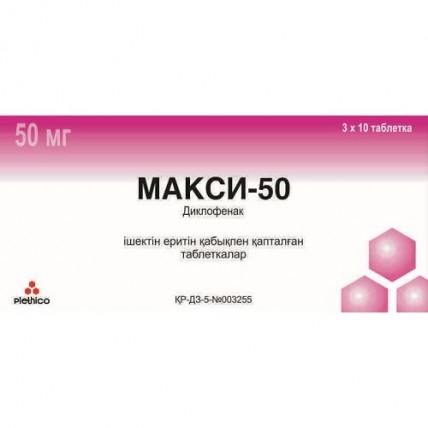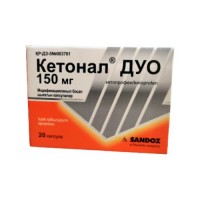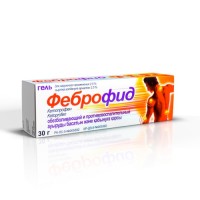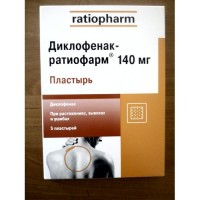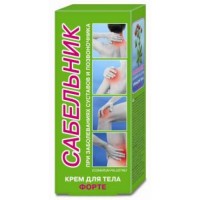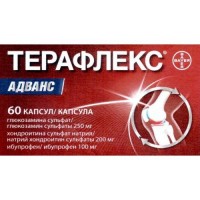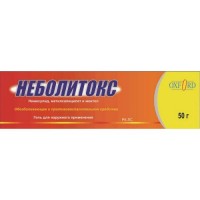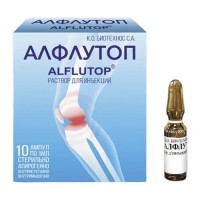Maxi Diclofenac 50 mg (30 tablets)
- $4.80
Out Of Stock
The instruction for medical use of Maksitm-50 medicine the Trade name of Maksitm-50 the International unlicensed name Diclofenac Dosage Form of the Tablet, covered with a kishechnorastvorimy cover, 50 mg Structure One tablet contains active agent - diclofenac of sodium of 50 mg, excipients: corn starch, cellulose microcrystalline, sodium of starch of glucoarmour, the talc purified silicon dioxide colloidal, magnesium stearate, structure of a cover: humidifier of a cover (IC-MS-2321), covering of TN-II (IEN-II-109) **, 2 propyl alcohol, methylene dichloride. **-structure of a covering: diethyl phthalate, 2 propyl alcohol, acetone. The description the Round biconvex tablets covered with a kishechnorastvorimy cover of white or almost white color. Pharmacotherapeutic group Drugs for treatment of diseases of a musculoskeletal system. Protivospalitelny and antirheumatic drugs. Non-steroidal anti-inflammatory drugs. Acetic acid derivatives. Diclofenac. ATX M01AB05 code the Pharmacological Pharmacokinetics Diclofenac properties is well soaked up after intake. The maximum concentration in blood is reached on average in 2 hours after reception. About a half of the entered diclofenac is metabolized during the first passing through a liver. Diclofenac contacts blood proteins for 99%. Gets into synovial fluid where the maximum concentration are defined in 2-4 hours after achievement of peak values in plasma. In two hours after achievement of peak values in plasma of concentration of active agent is already higher in synovial fluid, than in plasma, and remain higher within 12 hours. Diclofenac in the form of metabolites, mostly with urine (60%) is removed. Less than 1% are removed in not changed look. The rest is removed with bile and a stake. The pharmacokinetic behavior does not change at repeated introduction. Accumulation does not happen if the recommended intervals and dosages are observed. At elderly people age differences in absorption, metabolism or excretion of drug were not revealed. The pharmacodynamics tablet Drug Maksitm-50, coated, is non-steroidal anti-inflammatory drug. Renders expressed the anti-inflammatory, anesthetizing and moderate febrifugal action. The mechanism of effect of diclofenac is caused by suppression of activity of enzyme of cyclooxygenase therefore synthesis of PGE2, PGF2α prostaglandins, A2 thromboxane, prostacyclin, leukotrienes and emission of lizosomalny enzymes which play a major role in pathogenesis of inflammation, pain and fever is broken. Diclofenac suppresses aggregation of thrombocytes. In rheumatic diseases diclofenac reduces a joint pain at rest and at the movement, morning constraint, a swelling of joints, improves their functional capacity. At the inflammatory processes arising after operations and injuries quickly facilitates both spontaneous pain, and an oxycinesia, reduces inflammatory hypostasis on the place of a wound. Indications Adult and elderly people: Wide range of the diseases which are followed by pain and inflammation of different degree including: - the pseudorheumatism, the osteoarthritis ankylosing a spondylarthritis, acute gout - acute skeletal and muscular disorders, such as periarthritis, tendinitis, tendosinoviit, a bursitis - the painful states resulting from an injury (including changes), back pains, stretchings, deformations, dislocations, orthopedic, dental and other small operations. The route of administration and doses take Drug Maksitm-50 inside, without chewing, with enough liquid directly to or at the beginning of meal. At hypersensitivity of a stomach accept Maksitm-50 in the end or after meal. In acute pains it is recommended to accept before meal since reception of Maksitm-50 after meal complicates intake of active ingredient in blood. The dosage and duration of treatment establishes the attending physician, depending on features of a course of the disease and weight of a state. In rheumatic diseases the drug treatment can be long. The recommended dose for adults fluctuates within 75-150 mg the day divided into 2-3 receptions. The recommended maximum daily dose of Maksitm-50 makes 150 mg. Side effects Frequency is established with use of the following gradation: To Ochen frequent (≥ 1/10), frequent (≥ 1/100, & lt, 1/10), infrequent (≥ 1/1,000, & lt, 1/100), rare (≥ 1/10,000, & lt, 1/1,000), very rare (& lt, 1/10,000), it is unknown (it is impossible to define proceeding from the available data). In each group the side effects are located as reduction of weight of reaction. Narusheniya from blood and lymphatic system of Ochen seldom Thrombocytopenia, a leukopenia, anemia (including hemolytic and aplastic anemia), Narusheniya's agranulocytosis from the immune system Seldom Hypersensitivity, an acute anaphylaxis and anaphylactoid reactions (including hypotension and shock) seldom Quincke's disease (including a face edema) Mental disturbances of Ochen seldom the Disorientation, a depression, insomnia, nightmares, irritability, mental disorders of Narusheniya from nervous system Often the Headache, dizziness Seldom Drowsiness, Ochen's fatigue seldom Paresthesia, disturbance of memory, a spasm, uneasiness, a tremor, aseptic meningitis, disturbance of taste, disturbance of cerebral circulation Is unknown to Ochen Confusion of consciousness, a hallucination, disturbance of sensitivity, a general malaise of Narusheniya from Ochen's sight seldom Visual disturbance, a sight zatumanennost, a diplopia Vertigo Ochen Does not know the Optic neuritis of Narusheniya from an organ of hearing and balance Often seldom Sonitus, a hearing disorder Heart diseases of Ochen Heartbeat, a stethalgia, heart failure, a myocardial infarction Vascular disorders of Ochen seldom the Hypertension, hypotonia, Narusheniya's vasculitis is rare from respiratory organs, a thorax and mediastinum Seldom Asthma (including dispnoe) Ochen seldom Narusheniya's Pneumonitis from digestive tract Often Nausea, vomiting, diarrhea, dyspepsia, an abdominal pain, a meteorism, anorexia Seldom Gastritis, gastrointestinal bleedings, a hematemesis, diarrhea hemorrhagic, a melena, gastrointestinal ulcers with or without bleeding, or perforation (sometimes from the death, especially at elderly people) Ochen seldom Colitis (including hemorrhagic colitis and exacerbation of ulcer colitis or Crohn's disease), a constipation, stomatitis (including a stomacace), a glossitis, esophageal disorder, phrenic and intestinal strictures, Narusheniya's pancreatitis from a liver and biliary tract Increase in level of transaminases Seldom Hepatitis, jaundice, disorders is frequent from Ochen's liver seldom Lightning hepatitis, liver necrosis, a liver failure of Narusheniya from skin and hypodermic cellulose Often Rash Seldom Ochen's Small tortoiseshell seldom Bullous rashes, eczema, an erythema, a multiformny erythema, Stephens-Johnson's syndrome, a toxic epidermal necrolysis (Lyell's disease), dermatitis exfoliative, a hair loss, reactions of photosensitivity, purple, the allergic purpura, naggers Narusheniya from kidneys and urinary tract of Ochen seldom Acute renal failure, a hamaturia, a proteinuria, a nephrotic syndrome, interstitial nephrite, renal papillary necrosis the General disorders and disturbances in the injection site Often Reaction on the place of an injection, pain in the place of an injection, consolidation on the place of an injection Seldom Hypostases, abscess in the place of an injection, necrosis in the place of an injection of Narusheniya from genitals and a mammary gland of Ochen seldom Impotence * Frequency reflects data of long-term treatment in a high dose (150 mg a day). Clinical trials and epidemiological data indicate the increased risk of arterial trombotichesky complications (for example, a myocardial infarction or a stroke), connected with diclofenac use, especially in high doses (150 mg a day) and at long-term treatment. Experts of health care are offered to report about any side reactions to the address: metabolcompany@mail.ru of the Contraindication - hypersensitivity to diclofenac and other components of drug - a peptic ulcer of a stomach and duodenum, bleeding or perforation. - existence in the anamnesis of gastrointestinal bleeding or the perforation connected with the previous therapy of NPVP - the last trimester of pregnancy - a liver failure - a renal failure - heavy heart failure, coronary heart disease, hemorrhagic diathesis, cerebrovascular diseases (including suspicion of bleeding) - allergic reaction to other non-steroidal anti-inflammatory drugs (NPVP), for example, acetylsalicylic acid, an ibuprofen which can be expressed by asthma urticaria, acute rhinitis or other allergic symptoms - children's and teenage age up to 18 years Medicinal interactions Below-mentioned interactions were observed at use of diclofenac in the form of solution for injections, in the form of tablets and/or other dosage forms of diclofenac. Lithium: at a concomitant use with diclofenac the concentration of lithium in blood plasma can increase. Monitoring of level of lithium in blood serum is recommended. Digoxin: diclofenac can increase concentration of digoxin in blood plasma. Monitoring of level of digoxin in blood serum is recommended. Diuretics and antihypertensive drugs: the accompanying diclofenac use, as well as other NPVS, with diuretics and antihypertensives (for example, beta-blockers, inhibitors of angiotensin-converting enzyme (APF)) can lead to decrease in their antihypertensive effect by inhibition of synthesis of vasodilating prostaglandins. Thus, it is necessary to appoint a similar combination with care, and patients, especially advanced age, have to be under careful control of arterial blood pressure. Patients have to receive sufficient hydration, monitoring of renal function after the beginning of the accompanying therapy and after it, especially concerning diuretics and APF inhibitors because of increase in risk of nephrotoxicity is also recommended. The drugs causing a hyperpotassemia: the accompanying treatment with kaliysberegayushchy diuretics, cyclosporine, takrolimusy or Trimethoprimum can cause increase in level of potassium in blood serum therefore it is necessary to carry out monitoring. Anticoagulants and antithrombocytic agents: it is necessary to be careful as their simultaneous use can increase risk of developing bleeding. There are separate data on increase in risk of bleeding at the patients receiving diclofenac and anticoagulant at the same time. Therefore, careful monitoring of such patients is required. As well as other non-steroidal anti-inflammatory drugs, diclofenac in a high dose can inhibit aggregation of thrombocytes reversibly. Other NPVS, including cyclooxygenase-2 inhibitors, selection inhibitors and corticosteroids: combined use of diclofenac with other system NPVS or corticosteroids can increase risk of gastrointestinal bleeding or ulcer. Avoid use of two or more NPVS. Selective Serotonin Reuptake Inhibitors (SSRI): simultaneous use of SIOZS can increase risk of gastrointestinal bleeding. Antidiabetic drugs: clinical trials showed that the concomitant use of diclofenac with oral anti-diabetic drugs does not affect their clinical effect. However, there are messages about the effects of a hypoglycemia and a hyperglycemia demanding modification of a dosage of antidiabetic means during treatment by diclofenac. For this reason the monitoring of level of glucose in blood as a precautionary measure is recommended during the accompanying therapy. Methotrexate: it is necessary to be careful when assigning NPVP less than in 24 hours prior to or after reception of a methotrexate as in such cases the concentration of a methotrexate in blood can increase and amplify its toxic action. Tsikloporin and takrolimus: diclofenac, as well as other NPVS, can increase nephrotoxicity of cyclosporine owing to influence on renal prostaglandins. The same risk arises at treatment takrolimusy. In this regard, diclofenac should be entered in smaller doses, than to the patients who are not receiving cyclosporine and/or takrolimus. Antibacterial agents - derivatives of a hinolon: there are separate messages about development of spasms in patients, the receiving at the same time derivative hinolon and NPVP. Phenytoinum: when using Phenytoinum in parallel with diclofenac, monitoring of concentration of Phenytoinum in blood plasma in connection with the expected increase in concentration and toxicity of Phenytoinum is recommended. Kolestipol and holestiramin: These drugs can cause a delay or decrease in absorption of diclofenac. Therefore it is recommended to accept diclofenac at least in 1 hour prior to or in 4 - 6 hours after introduction of a kolestipola/holestiramin. Cardiac glycosides: Simultaneous use of cardiac glycosides and NPVS for patients can lead to strengthening of heart failure, decrease in SKF and increase in levels of glycosides in blood plasma. Mifepristone: NPVS should not be used within 8-12 days after administration of mifepristone as NPVS can reduce effect of mifepristone. Powerful CYP2C9 inhibitors: it is recommended to be careful at joint prescribing of diclofenac with powerful CYP2C9 inhibitors (for example, vorikonazol) which can lead to significant increase in its concentration in blood plasma at the expense of diclofenac metabolism inhibition. Special instructions For reduction of risk of development of the undesirable phenomena from digestive tract it is necessary to use a minimal effective dose minimum possible short course. It is necessary to avoid use of drug Maksitm-50 with system NPVP, including selection inhibitors of cyclooxygenase-2, in view of lack of any synergy advantage and a possibility of development of additional side effects. It is necessary to be careful when prescribing drug to elderly people. With poor health and for patients with a low indicator of body weight it is recommended to apply the lowest effective doses to people of advanced age. Seldom or never, without preliminary exposure of diclofenac, as well as in a case with other NPVP, there can be allergic reactions, including anaphylactic/anaphylactoid reactions. Diclofenac, as well as other NPVP, thanks to the pharmakodinamichesky properties can mask manifestations and symptoms of infectious diseases. Influence on digestive system. As well as at use of other NPVP, when prescribing drug Maksi™-50, medical observation and extra care is obligatory for patients with the symptoms demonstrating disturbances from the digestive system (DS) with presence of stomach ulcer or intestines, bleeding or perforation in the anamnesis. The risk of developing of bleeding in digestive tract increases with increase in a dose of drug at patients with an ulcer in the anamnesis, especially with complications in the form of bleeding or perforation, and at people of advanced age. To reduce risk of toxic impact on PS at patients with an ulcer in the anamnesis, especially with complications in the form of bleeding or perforation and at people of advanced age, treatment is begun and supported by low effective doses. For such patients and also the patients needing the accompanying use of medicines which presumably increase risk of undesirable impact on PS it is necessary to consider a question of use of combination therapy using protective equipment (for example, inhibitors of the proton pump or a mizoprostol). Patients with digestive tract diseases in the anamnesis, especially advanced age, have to report about any unusual abdominal symptoms (especially bleedings in PS). Cautions are also necessary for the patients receiving the accompanying medicines which can increase risk of developing an ulcer or bleeding, such as system corticosteroids, anticoagulants, antitrombotichesky means or selective serotonin reuptake inhibitors. Макси™-50 it is necessary to appoint with care the patient in whose anamnesis there are inflammatory bowel diseases, such as Crohn's disease or nonspecific ulcer colitis and to establish careful medical control in sv
zi with potential aggravation. Influence on a liver. Careful medical control is necessary in case diclofenac is appointed to patients with an abnormal liver function as their disease can become aggravated. As well as at use of other NPVP, the level of one and more hepatic enzymes can increase. During long-term treatment, regular control of function of a liver is appointed drug Maksi™-50. If abnormal liver functions remain and also if symptoms of progressing of a disease of a liver or other manifestations appear (for example, an eosinophilia, rash), use of drug Maksi™-50 should be stopped. The course of hepatitis can pass without prodromal symptoms. The care is necessary in case Maksi™-50 is applied at patients with a hepatic porphyria, because of the probability of provocation of an attack. Influence on kidneys. As at treatment of NPVP it was reported about a delay of liquid and hypostases, special attention should be paid to patients with dysfunction of heart or kidneys, arterial hypertension in the anamnesis, to the patients of advanced age, patients receiving the accompanying therapy by the diuretics or drugs significantly influencing renal function and to patients with significant reduction of extracellular volume of liquid for any reasons, for example, to or after serious surgical intervention. In such cases, as a precautionary measure, monitoring of renal function is recommended. The termination of therapy of NPVP usually leads to return to a state which preceded treatment. Skin reactions. Due to the use of NPVP, including diclofenac, it was very seldom reported about heavy skin reactions, such as exfoliative dermatitis, Stephens's syndrome - Johnson and a toxic epidermal necrolysis. The highest risk of these reactions - at the beginning of therapy, and development of these reactions is noted in most cases in the first month of treatment. Макси™-50 it is necessary to cancel at the first manifestations of skin rash, the centers of injury of a mucous membrane or any other manifestations of hypersensitivity. System Lupus Erythematosus (SLE) and diseases of connective tissue. Patients with a system lupus erythematosus and diseases of connective tissue have an increased risk of developing aseptic meningitis. Cardiovascular and cerebrovascular effects. Patients with the increased risk factor of development of cardiovascular complications (for example, a hypertension, a lipidemia, diabetes, smoking) should appoint diclofenac only after careful survey. To such persons the lowest effective daily dose has to be appointed. Need of the patient for relief of symptoms and reaction to therapy should be estimated repeatedly periodically. The corresponding monitoring and consultations are necessary for patients with a hypertension and/or easy to moderate stagnant heart failure as the delay of liquid and hypostases were registered in connection with therapy of NPVP, including diclofenac. Treatment of NPVP, including diclofenac, especially in high doses and during the long period, can be connected with increase in risk of serious cardiovascular cases (including a myocardial infarction and a stroke). At the patients accepting NPVP, especially at patients with cardiovascular risk factors it is necessary to apply a minimal effective dose to minimizing of potential risk of collateral cardiovascular complications at the smallest admissible duration of treatment. At patients with uncontrollable arterial hypertension, the stagnant heart failure established by coronary heart disease, diseases of peripheral vessels and/or cerebrovascular diseases it is necessary to apply diclofenac only after careful survey. Influence on hematologic indicators. At prolonged use of drug, as well as other NPVP, blood test monitoring is recommended. As well as other NPVP, diclofenac can temporarily inhibit aggregation of thrombocytes. It is necessary to watch carefully patients with disturbances of a hemostasis. Asthma in the anamnesis. At patients with bronchial asthma, seasonal allergic rhinitis, a rhinedema (nasal polyps), with the chronic obstructive diseases of lungs or persistent infections of airways (which are especially connected with allergic symptoms) more often than others have reactions to NPVP similar to exacerbation of asthma, a Quincke's edema or urticaria. Special security measures (readiness for rendering emergency aid) are recommended to such patients. It also concerns patients with an allergy to other substances, for example, with skin reactions, an itching or urticaria. Fertility. Diclofenac can affect fertility of the woman. Drug is not recommended to the women planning pregnancy. The women having complications with fertilization or those which underwent inspection owing to an infertilnost have to stop drug use. Features of influence of medicine on ability to run the vehicle or potentially dangerous mechanisms Considering side effects of drug (dizziness, a headache) it is necessary to be careful at control of transport or other potentially dangerous mechanisms. Overdose Symptoms: There is no typical clinical picture. The overdose can cause such symptoms as a headache, nausea, vomiting, pains in epigastric area, gastrointestinal bleedings, diarrhea, dizziness, a disorientation, excitement, a coma, drowsiness, sonitus, faints or spasms. In case of considerable poisoning the acute renal failure and injury of a liver Treatment are possible: Specific antidote does not exist. In case of overdose it is necessary to cause vomiting, to wash out a stomach and to appoint activated carbon. Symptomatic drug treatment. In hard cases - a hemodialysis or hemoperfusion. The form of release and packing On 10 tablets pack into blister strip packaging from a film of PVC and aluminum foil. On 3 blister strip packagings together with the instruction for medical use in the state and Russian languages place in a cardboard pack. To Store storage conditions in the dry, protected from light place at a temperature not above 25 °C. To store out of children's reach! Not to apply a period of storage of 5 years after an expiration date. Prescription status According to the prescription of Proizvoditel Pletkhiko Pharmasyyutikalz Ltd of A.B. Road, Mangliya-453,771, Indore (L. S.), India Holder of the registration certificate of Plethico Laboratories Pvt. Ltd. 38, Industrial Estate, Pologround, Indore – 452,015, (M.P.), India the Address of the organization accepting in the territory of the Republic of Kazakhstan a claim (offer) from consumers on quality of medicine and responsible for post-registration observation of safety of medicine of Metabol Kazakhstan LLP, 100009, Karaganda, Ermekov St. 110/2 ph. +7 (212) 48-16-44, fax +7 (212) 48-17-44 the e-mail address:
To Develop metabolcompany@mail.ru
zi with potential aggravation. Influence on a liver. Careful medical control is necessary in case diclofenac is appointed to patients with an abnormal liver function as their disease can become aggravated. As well as at use of other NPVP, the level of one and more hepatic enzymes can increase. During long-term treatment, regular control of function of a liver is appointed drug Maksi™-50. If abnormal liver functions remain and also if symptoms of progressing of a disease of a liver or other manifestations appear (for example, an eosinophilia, rash), use of drug Maksi™-50 should be stopped. The course of hepatitis can pass without prodromal symptoms. The care is necessary in case Maksi™-50 is applied at patients with a hepatic porphyria, because of the probability of provocation of an attack. Influence on kidneys. As at treatment of NPVP it was reported about a delay of liquid and hypostases, special attention should be paid to patients with dysfunction of heart or kidneys, arterial hypertension in the anamnesis, to the patients of advanced age, patients receiving the accompanying therapy by the diuretics or drugs significantly influencing renal function and to patients with significant reduction of extracellular volume of liquid for any reasons, for example, to or after serious surgical intervention. In such cases, as a precautionary measure, monitoring of renal function is recommended. The termination of therapy of NPVP usually leads to return to a state which preceded treatment. Skin reactions. Due to the use of NPVP, including diclofenac, it was very seldom reported about heavy skin reactions, such as exfoliative dermatitis, Stephens's syndrome - Johnson and a toxic epidermal necrolysis. The highest risk of these reactions - at the beginning of therapy, and development of these reactions is noted in most cases in the first month of treatment. Макси™-50 it is necessary to cancel at the first manifestations of skin rash, the centers of injury of a mucous membrane or any other manifestations of hypersensitivity. System Lupus Erythematosus (SLE) and diseases of connective tissue. Patients with a system lupus erythematosus and diseases of connective tissue have an increased risk of developing aseptic meningitis. Cardiovascular and cerebrovascular effects. Patients with the increased risk factor of development of cardiovascular complications (for example, a hypertension, a lipidemia, diabetes, smoking) should appoint diclofenac only after careful survey. To such persons the lowest effective daily dose has to be appointed. Need of the patient for relief of symptoms and reaction to therapy should be estimated repeatedly periodically. The corresponding monitoring and consultations are necessary for patients with a hypertension and/or easy to moderate stagnant heart failure as the delay of liquid and hypostases were registered in connection with therapy of NPVP, including diclofenac. Treatment of NPVP, including diclofenac, especially in high doses and during the long period, can be connected with increase in risk of serious cardiovascular cases (including a myocardial infarction and a stroke). At the patients accepting NPVP, especially at patients with cardiovascular risk factors it is necessary to apply a minimal effective dose to minimizing of potential risk of collateral cardiovascular complications at the smallest admissible duration of treatment. At patients with uncontrollable arterial hypertension, the stagnant heart failure established by coronary heart disease, diseases of peripheral vessels and/or cerebrovascular diseases it is necessary to apply diclofenac only after careful survey. Influence on hematologic indicators. At prolonged use of drug, as well as other NPVP, blood test monitoring is recommended. As well as other NPVP, diclofenac can temporarily inhibit aggregation of thrombocytes. It is necessary to watch carefully patients with disturbances of a hemostasis. Asthma in the anamnesis. At patients with bronchial asthma, seasonal allergic rhinitis, a rhinedema (nasal polyps), with the chronic obstructive diseases of lungs or persistent infections of airways (which are especially connected with allergic symptoms) more often than others have reactions to NPVP similar to exacerbation of asthma, a Quincke's edema or urticaria. Special security measures (readiness for rendering emergency aid) are recommended to such patients. It also concerns patients with an allergy to other substances, for example, with skin reactions, an itching or urticaria. Fertility. Diclofenac can affect fertility of the woman. Drug is not recommended to the women planning pregnancy. The women having complications with fertilization or those which underwent inspection owing to an infertilnost have to stop drug use. Features of influence of medicine on ability to run the vehicle or potentially dangerous mechanisms Considering side effects of drug (dizziness, a headache) it is necessary to be careful at control of transport or other potentially dangerous mechanisms. Overdose Symptoms: There is no typical clinical picture. The overdose can cause such symptoms as a headache, nausea, vomiting, pains in epigastric area, gastrointestinal bleedings, diarrhea, dizziness, a disorientation, excitement, a coma, drowsiness, sonitus, faints or spasms. In case of considerable poisoning the acute renal failure and injury of a liver Treatment are possible: Specific antidote does not exist. In case of overdose it is necessary to cause vomiting, to wash out a stomach and to appoint activated carbon. Symptomatic drug treatment. In hard cases - a hemodialysis or hemoperfusion. The form of release and packing On 10 tablets pack into blister strip packaging from a film of PVC and aluminum foil. On 3 blister strip packagings together with the instruction for medical use in the state and Russian languages place in a cardboard pack. To Store storage conditions in the dry, protected from light place at a temperature not above 25 °C. To store out of children's reach! Not to apply a period of storage of 5 years after an expiration date. Prescription status According to the prescription of Proizvoditel Pletkhiko Pharmasyyutikalz Ltd of A.B. Road, Mangliya-453,771, Indore (L. S.), India Holder of the registration certificate of Plethico Laboratories Pvt. Ltd. 38, Industrial Estate, Pologround, Indore – 452,015, (M.P.), India the Address of the organization accepting in the territory of the Republic of Kazakhstan a claim (offer) from consumers on quality of medicine and responsible for post-registration observation of safety of medicine of Metabol Kazakhstan LLP, 100009, Karaganda, Ermekov St. 110/2 ph. +7 (212) 48-16-44, fax +7 (212) 48-17-44 the e-mail address:
To Develop metabolcompany@mail.ru
